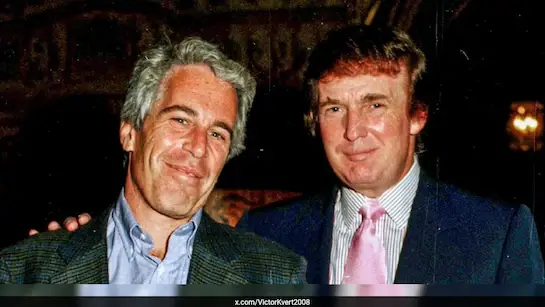A major news network’s recent investigative report has sparked unexpected backlash, not for its content, but for how that content was presented to the public. What was billed as groundbreaking exclusive material has instead become the center of a heated debate about journalistic standards, media credibility, and the fine line between legitimate reporting and sensationalism in today’s hypercharged political environment.
The Phone Call That Lasted Just 30 Seconds
President Donald Trump abruptly ended a phone conversation with CNN reporter Andrew Kaczynski on Tuesday after just 30 seconds when questioned about recently surfaced photographs showing Jeffrey Epstein at significant events in the president’s past. The brief exchange would soon become emblematic of larger tensions between the current administration and major news outlets.
The photographs in question, obtained through CNN’s KFile investigative unit, captured Epstein’s presence at Trump’s 1993 wedding to his second wife, Marla Maples, held at the prestigious Plaza Hotel. Additional images showed the convicted sex offender mingling with Trump and his children at a Harley-Davidson Cafe event during the same year, providing a visual record of their social interactions during the early 1990s.
The timing of this reporting, coming more than three decades after the events depicted, raised immediate questions about the newsworthiness and relevance of the material. Yet the images themselves offered a window into the social circles and business relationships that characterized New York’s elite during that era, when Trump was establishing himself as a major figure in Manhattan’s high-society scene.
The “Exclusive” That Wasn’t
During Tuesday night’s broadcast, CNN presenter Erin Burnett introduced the story with considerable fanfare, describing the photographic material as having “never been seen” before and positioning it as part of a comprehensive archive investigation. The presentation suggested that viewers were witnessing the unveiling of previously hidden evidence that could shed new light on the relationship between the current president and the disgraced financier.
However, the exclusive nature of the report quickly came under scrutiny when it was revealed that the photographs were actually readily available through common online platforms. In a moment that would prove embarrassing for the network, Kaczynski was forced to acknowledge that the images could be found on Google Images and within Shutterstock’s extensive content collection, platforms accessible to anyone with an internet connection.
This revelation fundamentally undermined the story’s presentation as breaking news or exclusive content. Instead of uncovering hidden evidence, CNN had essentially repackaged publicly available material and presented it as a journalistic scoop. The discrepancy between the story’s presentation and its actual substance would become a central point of criticism from both political opponents and media observers.
Kaczynski attempted to salvage the story’s significance by arguing that the photographs maintained “fresh relevance” because they “have not been widely reported and predate any of Epstein’s known legal issues.” This explanation suggested that the timing and context of the images, rather than their exclusivity, justified th
eir prominent coverage in the current news cycle.
A Presidential Response True to Form
The conversation between Kaczynski and President Trump, though brief, provided insight into how the current administration handles media inquiries about sensitive topics. According to Kaczynski’s account, shared during his subsequent appearance with Burnett, the president’s reaction was swift and characteristically direct.
“We were not on the phone very long. I think our call was about 30 seconds or so. But when I asked him about the wedding photo, he sort of paused for a second and then said, ‘you’ve got to be kidding me’ before calling CNN ‘fake news’ and then hanging up on me,” Kaczynski recounted to viewers.
This exchange exemplified the contentious relationship between Trump and CNN, which has been marked by mutual antagonism and public disputes over coverage fairness and accuracy. The president’s quick dismissal of the inquiry and his use of the “fake news” characterization reflected his standard approach to media stories he considers unfavorable or unfair.
The brief nature of the call also highlighted the challenges journalists face when attempting to obtain official responses to sensitive inquiries. In an era of rapid news cycles and heightened political tensions, the traditional practice of seeking comment before publication has become increasingly difficult to execute effectively.
Official White House Pushback
The Trump administration’s formal response came through White House Communications Director Steven Cheung, who issued a statement that went beyond simply dismissing the photographs’ significance. Cheung’s response attacked both the content and the methodology of CNN’s reporting, characterizing the entire exercise as a deliberate misrepresentation of innocent social interactions.
“These are nothing more than out-of-context frame grabs of innocuous videos and pictures of widely attended events to disgustingly infer something nefarious,” Cheung stated, using language that suggested the administration viewed the report as a deliberate attempt at character assassination rather than legitimate journalism.
The statement continued with additional context that the White House clearly wanted emphasized: “The fact is that the President kicked him out of his club for being a creep. This is nothing more than a continuation of the fake news stories concocted by the Democrats and the liberal media.”
This response strategy served multiple purposes for the administration. First, it provided counter-narrative by emphasizing Trump’s eventual decision to distance himself from Epstein, suggesting that any past association should be viewed in light of the president’s later actions. Second, it positioned the entire story within the broader framework of partisan media bias, attempting to discredit the reporting by questioning its motivations rather than its factual accuracy.
Conservative Critics Pounce on the Story
The revelation that CNN’s “exclusive” photographs were actually publicly available provided ammunition for conservative critics who have long argued that mainstream media outlets engage in biased or misleading reporting about Trump. Conservative influencer Eric Daugherty was among those who quickly seized on the discrepancy to mock the network’s presentation.
“CNN dropped an ‘exclusive,’ bombshell showing Trump at a wedding with Epstein – ‘newly discovered photos.’ The photos have been known for YEARS, all of this was public record. So CNN is reporting years-old news now just to further a hoax on Trump,” Daugherty wrote on X, using the controversy to reinforce broader narratives about media credibility and anti-Trump bias.
This type of criticism reflected a larger pattern in contemporary political discourse, where media missteps become opportunities for partisan scoring and broader attacks on institutional credibility. The fact that the photographs were indeed publicly available provided conservatives with concrete evidence to support their claims about misleading media coverage.
The incident also highlighted the risks that news organizations face in today’s intensely scrutinized media environment. What might have once been considered a minor presentation error now becomes fodder for sustained criticism and broader questions about editorial judgment and reporting standards.
The Broader Context of Epstein Revelations
While the CNN story faced criticism for its presentation, it occurred within a broader context of ongoing public interest in Jeffrey Epstein’s connections to powerful figures across politics, business, and entertainment. The convicted sex offender’s death in federal custody in 2019 while awaiting trial on sex trafficking charges left many questions unanswered about his activities and associates.
Recent developments have continued to fuel public curiosity about these connections. Earlier in the week, former Harvard Law professor Alan Dershowitz, who had previously served on Epstein’s legal team during his 2008 case, made headlines by naming several prominent Democratic figures whom he claimed appear in Epstein-related files.
Speaking to Fox News Sunday host Shannon Bream, Dershowitz clarified the nature of these references: “There was never an official ‘client list,’ but noted that names can be uncovered through other means and that additional information is available.” This distinction was important because it addressed common misconceptions about the nature of documentation related to Epstein’s activities.
Dershowitz provided specific examples of the type of information available: “For example, there is an FBI report of interviews with alleged victims in which at least one of the victims names very important people, and the names have been redacted. I know some of the names from my investigation.”
Among the names he mentioned were “George Mitchell, the former senator [from Maine]; Bill Richardson, the former ambassador to the UN; [former Israeli Prime Minister] Ehud Barak … were all accused. Now, whether any of these people actually did anything wrong, we don’t know, because we know there have been many, many false accusations.”
This context was crucial because it demonstrated that questions about Epstein’s connections extend far beyond any single political figure or party. Mitchell, the 91-year-old former Democratic Senate Majority Leader who retired from public life in 2011, and Richardson, who served as governor of New Mexico before passing away in 2023, represented the bipartisan nature of concerns about Epstein’s social and professional networks.
Check it out below:

Adrian Hawthorne is a celebrated author and dedicated archivist who finds inspiration in the hidden stories of the past. Educated at Oxford, he now works at the National Archives, where preserving history fuels his evocative writing. Balancing archival precision with creative storytelling, Adrian founded the Hawthorne Institute of Literary Arts to mentor emerging writers and honor the timeless art of narrative.
